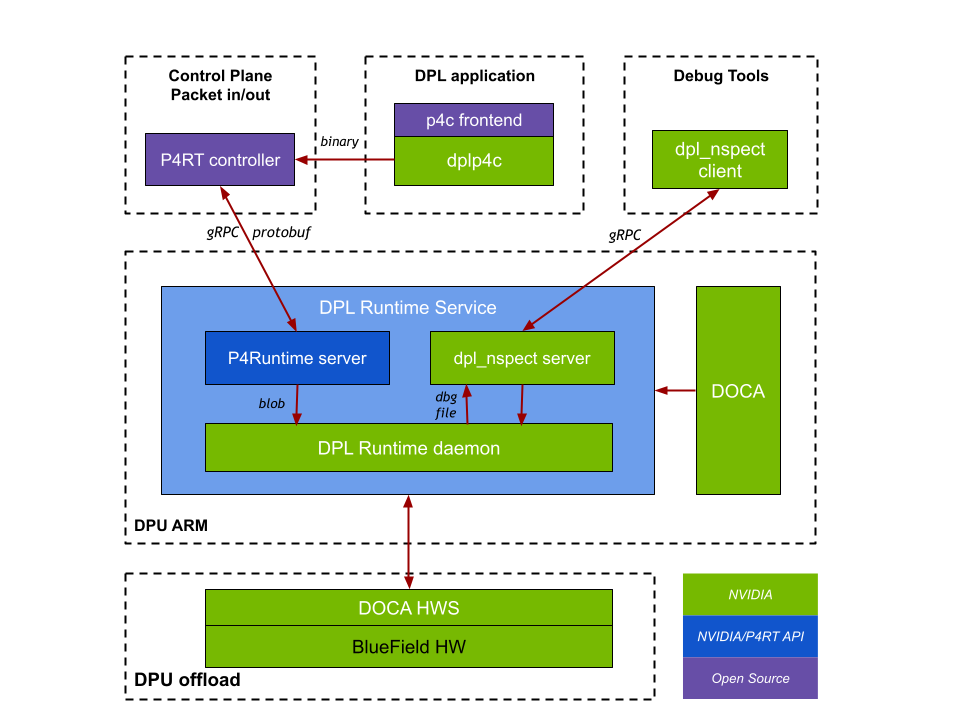DPL System Overview
Contents:
This document provides a high-level overview of the NVIDIA® DOCA Pipeline Language (DPL) system, which enables programmable packet processing on NVIDIA® BlueField® DPUs and SuperNICs using P4-based semantics.
DPL is a domain-specific programming framework based on the P4-16 language. While reusing P4 syntax, DPL introduces NVIDIA-specific semantics and architecture tailored for the BlueField platform. Rather than relying on C-based APIs, developers use DPL to define packet parsing, matching, and processing behavior directly in a high-level, declarative manner. This speeds up development and simplifies pipeline optimization.
A deployed DPL program is dynamically controlled using P4Runtime, an open-source, gRPC-based control plane interface. This allows rules and configurations to be updated at runtime without recompilation. Although DPL is compatible with any P4Runtime-compliant controller, future support for vendor-specific extensions is planned.
The DPL toolkit includes:
A compiler for building BlueField-optimized pipelines
A runtime service to manage hardware deployment and control-plane interaction
Debugging and inspection developer tools for introspecting the pipeline
Together, these components deliver a complete programmable pipeline platform optimized for BlueField devices.
BlueField-3 combines a ConnectX networking ASIC with an embedded Arm subsystem, providing high-performance networking and programmable packet processing. It supports offloading and acceleration of SDN, storage, and security functions.
DOCA Device Types
DPL supports two kinds of DOCA devices:
Local device – A PF, VF, or SF that is locally exposed to the system (host or BlueField).
Netdev representor – A proxy network interface on BlueField for a device on the host side. Representors allow the DPU to control and inspect traffic flowing to/from host-side devices.
Representor Naming
Uplink Representor –
p<port_number>PF Representor –
pf<port_number>hpfVF Representor –
pf<port_number>vf<function_number>SF Representor –
en<domain>f<function>pf<port_number>sf<function_number>
The host function's MTU must be smaller than that of both its uplink and representor.
In DPU mode, the BlueField owns NIC resources, and all host traffic flows through a virtual switch on the Arm subsystem before reaching the host.
Key characteristics:
Host-side NIC drivers load only after the BlueField completes NIC configuration
BlueField allocates all NIC memory (ICM)
BlueField configures the embedded switch, and all host traffic is intercepted
A compiled DPL pipeline executes within the embedded switch (eSwitch) and consists of:
A programmable packet parser (parse graph)
Match/action tables
Packet actions (e.g., forward, drop, modify, encrypt)

pf0hpfandpf1hpfare the representors facing the x86 hostpf0andpf1are the representors facing the network
The DPL solution on the BlueField DPU consists of multiple components working in tandem. These components are outlined below and shown in the following diagram:

DPL Compiler
The compiler, typically run from a host development system, generates:
P4Info file – Target-independent protobuf description used by controllers
Device config (
.dplconfig) – Binary blob for loading into BlueField hardwareOptional debug file – Used by inspection tools
P4 language reference: P4-16 v1.2.4 Documentation.
P4Runtime Controller
The P4Runtime Controller manages real-time updates and control of the pipeline. It must conform to P4Runtime v1.3.0 and communicates with BlueField using gRPC over TCP (default port 9559). Capabilities include:
Installing/removing rules
Querying table state
Handling packet-in/out traffic
Future API enhancements will be integrated to address BlueField insertion scale and rate requirements, significantly improving network performance and flexibility.
DPL Runtime Service (dpl_rtd)
The runtime service runs on the BlueField and:
Hosts the gRPC P4Runtime server
Processes incoming controller commands
Loads compiled pipeline artifacts
Interfaces with the DOCA HWS driver
Manages parse graphs, match tables, and state
Provides debug and monitoring services
DPL Nspect
DPL Nspect is a host-side CLI tool for:
Viewing table contents
Debugging DPL pipelines
Tracing packet path and action outcomes
It communicates with the runtime service's internal debug server.
P4Runtime Server
Implements gRPC endpoints for standard P4Runtime protocol messages. Converts P4Info operations into hardware actions using the DOCA HWS driver. The server is hosted within the DPL Runtime Service.
DPL Nspect Server
A backend service in the runtime daemon that handles debug and monitoring traffic. Communicates with the Nspect client and debugger tools over gRPC.
DOCA HWS Driver
The DOCA HWS Driver provides low-level APIs for pipeline construction and table management in BlueField hardware. The DPL compiler and runtime interface with this driver to install flows, modify match criteria, and define actions.
eSwitch Management
Developers are free to manage the eSwitch using tools like:
OVS (e.g., DOCA OVS)
DPDK-based apps
DOCA management interfaces
DPL does not constrain how virtual interfaces or bridges are configured.